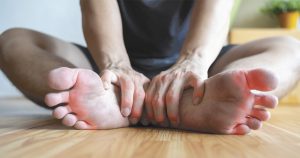 Arthritis is the presence of inflammation and swelling of the cartilage in the lining of the joints usually in the presence of increased fluid accumulation in the joints. The prevalence of arthritis increases with age, however, people of all ages can be affected. It is often associated with more than 100 identifiable disorders.
Arthritis is the presence of inflammation and swelling of the cartilage in the lining of the joints usually in the presence of increased fluid accumulation in the joints. The prevalence of arthritis increases with age, however, people of all ages can be affected. It is often associated with more than 100 identifiable disorders.
When we hear the term arthritis, most individuals think of joint pain within the hands, spine, hips and knees. We do not often realize arthritis can also affect our feet. Think about it: Did you know there are 33 joints in the average adult foot? Did you ever ponder the fact that your feet are carrying the entire weight of your body? When we think of it like that, arthritis is almost inevitable to present itself in our feet.
Arthritis can be hereditary, but there are numerous other causes. Often times, it is a result of an injury. Injuries of the foot and ankle often go ignored and predisposes us to resultant arthritis. It can also be a result of a bacterial or viral infection, systemic inflammatory diseases, autoimmune diseases, and drug related (prescription or otherwise).
There are numerous types of arthritis, including osteoarthritis, rheumatoid arthritis, gouty arthritis, psoriatic arthritis, and traumatic arthritis.
Osteoarthritis is most seen through normal wear-and-tear and increases in prevalence with age. Aging brings on a breakdown of a cartilage and pain gets progressively more severe. It presents as a dull throbbing pain most commonly at nighttime. Individuals who are overweight are also prone to it as the additional weight contributes to deterioration of cartilage and the development of bone spurs.
Rheumatoid arthritis may be considered the most serious form of arthritis. Rheumatoid arthritis is considered symmetrical meaning it may be found in the same joints in both feet or ankles. Symptoms usually include morning stiffness, fatigue and even weight loss. Rheumatoid is a systemic inflammatory disorder which also affects other parts of the body, not just our bones. Women are also 3-4 times more likely than men to suffer with rheumatoid arthritis. The onset of rheumatoid arthritis is more acute in comparison to osteoarthritis. There are times when the symptoms disappear, and environmental factors or physical activity may create a flare.
Gout is a condition caused by buildup of uric acid within the joints. This can create gouty arthritis which is often found in the foot as it is one of the cold is causing her bodies and the uric acid may crystallize within the joint. Gout attacks are extremely painful and debilitating. Men are more likely to be afflicted than women and may also be associated with “the rich man’s diet”.
Psoriatic arthritis is often found in conjunction with psoriasis, the skin disorder. One in 20 people with psoriasis will develop associated arthritis. Psoriatic arthritis is often found in the toes and seen alongside skin and nail changes.
Traumatic arthritis is a result of forced inappropriate motion of the joint or ligament or fractures and sprains. A bad sprain can still cause damage to the cartilage even if no fracture occurs.
Arthritis in the foot can present as swelling, tenderness, redness, warmth, decrease in motion of the involved joint, and morning stiffness. You may experience a dull ache as well as an occasional sharp pain to the joint.
In treating arthritis, we want to control inflammation and preserve joint function. By minimizing the motion of the involved joint, we may see control of the symptoms. In the feet, this can be done by wearing appropriate shoe gear or custom made orthotics. Physical therapy and medication do not only assist in appropriate mobility of the joints, but can improve health of associated ligaments and tendons which support those joints. If the arthritis is not adequately controlled conservatively, there are surgical procedures to address the involved joint.
Seek evaluation and treatment by a podiatrist sooner rather than later when noticing these symptoms in your feet. Treatment can become increasingly difficult as the arthritis worsens.
Disclaimer: This content is not intended to be a substitute for professional medical advice, diagnosis, or treatment. Always seek the advice of your physician or other qualified health care provider with any questions you may have regarding a medical condition.
Sahiba Singh DPM, AACFAS
For more information, you may contact Dr. Sahiba Singh at Family Foot & Leg Center at (239) 430 – 3668 (FOOT).
Family Foot & Leg Center has 8 locations throughout Collier, Lee, & Charlotte Counties to quickly resolve all your foot and ankle problems.
FAMILY FOOT & LEG CENTER
6846 International Center Blvd, Suite B
Fort Myers, FL 33912
(239) 430 – 3668 (FOOT)
www.NaplesPodiatrist.com









